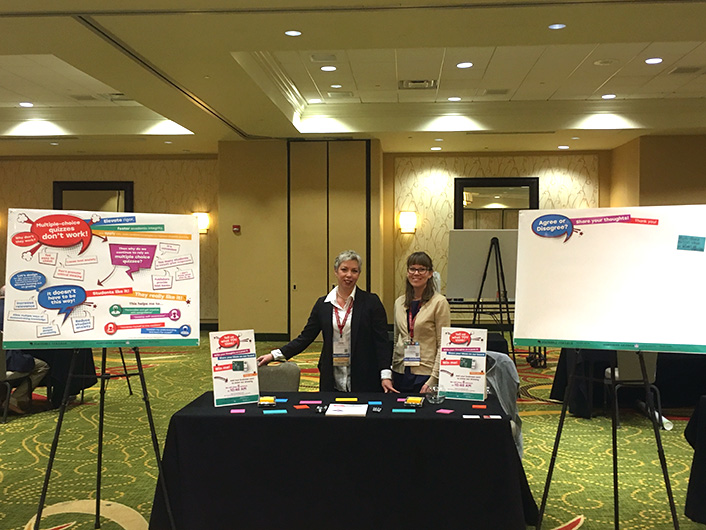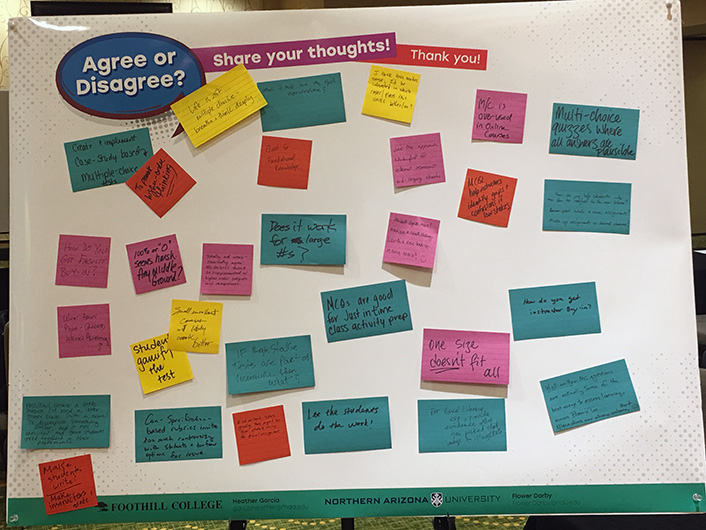Instructional designers have a unique opportunity to dive into the intersection between their discipline and faculty development in order to make significant contributions to teaching and learning at their institutions.

The role instructional designers (IDs) play in faculty professional development is often murky. Are we faculty developers? How does what we do overlap with the efforts of centers for teaching and learning? Should we be limited to presenting workshops on teaching and learning with technology?
Questions like these highlight one of many gray areas in the role of instructional design. We see ourselves as faculty developers, but this view is not always shared by faculty or others doing similar work. As we strive to be more effective in our roles, IDs have a unique opportunity to dive into the intersection between instructional design and faculty development and to make significant contributions to effective teaching and learning at our institutions.
These two issues, faculty development and instructional design, feature in the EDUCAUSE Learning Initiative's 2018 Key Issues in Teaching and Learning. As part of ID2ID, a new program co-sponsored by ELI and Penn State, we explored how these issues converge to result in stronger faculty development offerings with robust instructional design underpinnings. Our collaboration in the ID2ID program helped us explore exciting and innovative ways of supporting faculty.
Below we each share an example of faculty development work that was shaped by or grew out of our partnership in ID2ID. As you'll see, supporting each other in our instructional design roles leads to more effective support and development of our faculty as well.
Heather Garcia: Reimagining Faculty Development at Foothill College
Last fall, having completed a learning management system migration to Canvas, my colleagues in the Foothill College Online Learning department and I were ready to reimagine our role in faculty professional development. I was able to contribute to this process with the insights I gained through participation in the ID2ID program. That experience exposed me to new ways of defining my role as an ID and expanded my thinking about how to effectively provide faculty development.
Our struggles with offering faculty professional development are all too familiar to instructional designers and others in faculty development roles. We have trouble incentivizing faculty to attend our workshops and are often seen as technical support rather than a resource to help faculty improve pedagogy.
As my team and I reimagined how our office provides faculty professional development opportunities, we worked to overcome these struggles. Here is what we learned:
1. Make Your Workshops Convenient to Attend
Perhaps this one is obvious, but when you're working with online and hybrid faculty, you will increase attendance at your events if you offer the option to participate remotely. At Foothill, we have professional development (PD) days every quarter. We took advantage of this by offering our workshops as part of PD days rather than as stand-alone events.
2. Partner with Other Groups across Campus
By teaming up with other committees and colleagues across campus that are involved in faculty development, we have benefitted from greater marketing reach and logistical support for planning our events.
3. Extend Learning Beyond the Workshop
For most workshops we host, our team builds an online mini-course to accompany the training. In addition to earning professional growth award credits for attending our workshops, participants can earn additional hours and a badge by submitting evidence of their learning.
4. Include Faculty
Our workshops frequently feature panels in which faculty share their approaches to teaching and learning. We have found that this approach helps engage the audience, build community among faculty peers, and facilitate a discussion about pedagogy rather than technology.
5. Bring in the Student Voice
We have started soliciting more qualitative feedback from students for our workshops because the student voice is a powerful motivator for faculty. Our team is also supporting more faculty in their efforts to solicit feedback and gain permission from students to share their work.
6. Don't Just Demo Tech—Summarize Relevant Research
In our workshops, we have almost entirely moved away from demonstrating technology tools. If we exhibit a specific tool, we don't expect our faculty to leave the workshop with the ability to use it right away; this expectation is unrealistic and would set us up for failure. Instead, we aim to inspire and share possibilities, create dialogue, and generate new ideas. As part of this effort, we summarize relevant research during each of our workshops. Sharing research has also helped faculty see me and the rest of my team as more than just technical support personnel.
Flower Darby: Combining ID Theory and Teaching Practice
Faculty are struggling with increasing class sizes, cheating, and pressure to design alternative forms of assessment. To address these concerns — and as one of our ID2ID projects — we created a poster presentation titled "Elevate Rigor, Foster Academic Integrity, and Apply UDL: Tech-Enabled Strategies to Improve Student Learning" for the 2018 ELI Annual Meeting (see figure 1).

Presenting this material to a national audience allowed us to share ID theory in a practical way that impacts online and onsite classes. Our session presented solutions for all these challenges. Using specifications grading, we can accomplish several goals:
- Hold students accountable for higher-quality work without creating an unreasonable grading load.
- Proactively design for academic integrity.
- Offer students a variety of ways they can demonstrate achievement of learning outcomes.
We shared four things faculty can do to make their assessments more effective.
1. Change One Thing
Identify one place in your course where you can replace an auto-graded assessment.
2. Align Your Assessments to the Appropriate Level of Cognition
Is a multiple-choice or true/false test really the best way to measure higher-order thinking?
3. Create a Rubric in Your Learning Management System
Design a rubric to streamline grading. Using the rubric tool allows you to align rows to criteria and click your way through in a fast and efficient manner.
4. Implement, Evaluate, Adjust
Any new approach requires careful analysis. There's always something we can do to improve.
Our session was well received; we felt we'd contributed to faculty's understanding of effective assessment design and of universal design for learning in a way that they could implement in their teaching. Working together as two IDs from two institutions with two different approaches resulted in a robust faculty development offering (see figure 2).

The Intersection between Instructional Design and Faculty Development
IDs truly are faculty developers. We should be working with our centers for teaching and learning, creating meaningful resources to improve student success at our institutions. And no, IDs don't only support faculty in teaching with technology. We offer a wealth of knowledge about effective learning design no matter the modality.
The ID2ID program allowed us to connect with other IDs, which is hugely important in this evolving profession. As a profession, let's step into this intersection, offer practical strategies firmly grounded in theory, and contribute to improved teaching and learning in higher education.
Heather Garcia is an Instructional Designer at Foothill College.
Flower Darby is Senior Instructional Designer in the e-Learning Center at Northern Arizona University.
© 2018 Heather Garcia and Flower Darby. The text of this work is licensed under a Creative Commons BY-NC-ND 4.0 International License.
